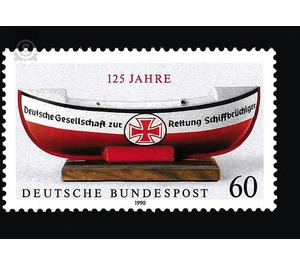125 years German Society for the Rescue of Shipwrecked People - Germany / Federal Republic of Germany 1990 - 60 Pfennig
Theme: Calender
| Country | Germany / Federal Republic of Germany |
| Issue Date | 1990 |
| Face Value | 60.00 |
| Color | red white |
| Perforation | K 14 |
| Printing Type | 5-color offset |
| Stamp Type | Postage stamp |
| Item Type | Stamp |
| Chronological Issue Number | 1338 |
| Chronological Chapter | GER-BRD |
| SID | 241837 |
| In 42 Wishlists | |
From rowing boat to Seenotkreuzer The German Society for Rescue of Shipwrecked (DGzRS) carries out the search and rescue service in distress in our areas of the North Sea and Baltic Sea - self-responsible and independent of state influences since 1865. Until the establishment of a uniform German Lifeboat rescue system, however a lengthy, arduous way in a then still politically fragmented Germany. November 1854 - in front of Spiekeroog the emigration ship JOHANNE is stranded in the heavy autumn storm. 84 people perish in the roaring sea. In September 1860, the brig ALLIANCE runs on the dreaded Borkum reef and sinks. No one lives on the crew of the sailor. So sailors had to die again and again because no rescue attempts were made by the islands or by land. Lack of equipment and organization and the still practiced beach right prevented an intervention to protect the shipwrecked from their terrible fate. In fact, the downfall of the ALLIANCE has become a blessing for shipping in retrospect, because in the following years it led to the construction of the first rescue stations on the German coasts. On the initiative of committed citizens finally on 29 May 1865 the German society for rescue shipwrecked ones was founded. In the beginning, only open rowboats and simple rocket sets and breeches could be used to rescue shipwrecked people. Only the development of space-saving, reliable diesel engines after the First World War allowed the switch to covered motorboats, which protected the rescue men from storm and breakers and their forces saved for the actual use. Today, the company has 36 powerful units; from the 7-meter lifeboat to the 44-m sea rescue cruiser, always ready to take on a variety of tasks in all weathers and at all times. The modern sea rescue cruiser is u. a. equipped with a daughter boat, on-board hospital and fire extinguishing systems and reaches speeds of up to 26 knots (about 48 km / h). On average, the DGzRS rescue men today drive more than 2,000 missions a year. Many people are rescued from distress or released from critical dangerous situations. Around 50,000 castaways owe their lives since the founding of the DGzRS to the rapid intervention of the sea rescue team. In many cases, doctors are urged to provide urgent assistance, and often the rescue men themselves have to provide first aid. Her other duties include the transport of sick and injured persons from seagoing ships, islands and hollows to the mainland as well as technical assistance for watercraft of all kinds. In the SEENOTLEITUNG BREMEN of the DGzRS (international name: Rescue Co-Ordination Center, RCC BREMEN) run in missions all Threads together. From here, the rescue measures of all vehicles involved - including other institutions and merchant shipping - centrally managed and coordinated. Experienced boaters are on duty around the clock in the RCC BREMEN. The most important prerequisite for successful work, despite all technical developments, is the constant readiness of the rescue men to be selfless and self-sacrificing - as they did 125 years ago. 120 permanent and more than 200 volunteer rescue men are currently providing their "service under the flag of humanity". Rescuing lives from distress, however, is a challenge that everyone - whether inland or on the coast - should feel obliged to. Since its founding, the German rescue service has been financed exclusively by voluntary contributions and therefore relies on support from all sides. Patron of the DGzRS is Federal President Richard von Weizsäcker. (Text: German Society for the Rescue of Shipwrecked Persons (DGzRS), Werderstraße 2, 28199 Bremen)


